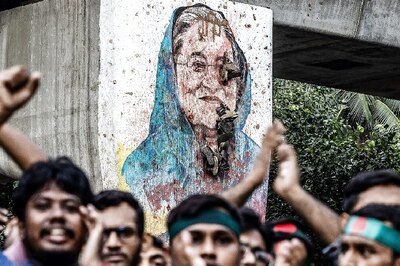
views
The Union Cabinet chaired by Prime Minister Narendra Modi has approved the women’s reservation bill which calls for providing a 33 percent quota to women in Parliament and state legislatures, multiple reports said.
Union Minister Prahlad Patel on Monday posted on social media site X post that the Union Cabinet has approved the tabling of the women’s reservation bill. However, the post was later deleted.
Several reports quoting sources have claimed that the Bill has received approval from the Union Cabinet. Meanwhile, many leaders have demanded the introduction of the women’s reservation bill in the special session of the Parliament, which began on Monday.
The opposition Congress also called for passing of the bill with party leader Jairam Ramesh saying, “The Congress Working Committee has demanded that the Women’s Reservation Bill must be passed during the Special Session of Parliament”.
The bill is expected to be tabled in the Parliament in the coming days, though it was not part of the agenda for the special session.
All about the Women’s Reservation Bill
The Women’s Reservation Bill seeks to reserve one-third of all seats in the Lok Sabha and the state legislative assemblies for women.
Moreover, one-third of the seats reserved for Scheduled Castes and Scheduled Tribes will be reserved for women from those groups. These reserved seats may be allotted to different constituencies in the state or union territory by rotation.
The Bill adds that the reservation of seats for women shall cease to exist 15 years after the commencement of this Amendment Act.
The demand for women’s reservation in Lok Sabha and state assemblies goes back to decades and there have been debates on the issue in the Constituent Assembly after the Independence. Here is a brief history of the demand for women’s reservation.
Government of India Act of 1935
The Act provided 41 reserved seats in provincial legislatures and limited reservations in Central Legislatures.
Laura Dudley Jenkins in her paper titled ‘Competing Inequalities: The Struggle Over Reserved Legislative Seats for Women in India’ writes, “In the last decades of colonial rule, Britain granted Indians limited rights to serve as representatives in legislative bodies. In part an effort to neutralize nationalists and expand the “circle of collaborators”, such policies also contributed to “divide and rule” tactics by giving special electoral rights to These policies include the 1909 Indian Councils Act (based on the Minto—Morely Report), the 1919 Government of India Act (based on the Montagu-Chelmsford Proposals), and the 1935 Government of India Act”.
She further explains, “This period also saw the first attempts at forming “All-India” women’s associations, such as the Women’s India Association (WIA) in 1917, followed by the All India Women’s Conference (AIWC) and the National Council of Women in India (NCWI).”
According to Jenkins, the major women associations tried to influence the new policies by passing resolutions, sending delegates to conferences, submitting memoranda and letters, and lobbying various decision makers.
“Their primary agenda was gaining the right to vote for Indian women, but they became involved in the issue of reserved seats for women in legislatures. Ironically, although these major Indian women’s organizations came down against such reservations, they were granted to them in 1935,” she added.
Constituent Assembly
The issue of women’s reservation was brought in the Constituent Assembly debates as well. However, it was rejected as being unnecessary.
It was argued that with a democratic setup and with universal adult franchise, representation will be ensured to women as well as others.
Renuka Ray in her speech in the Constituent Assembly said, “I rise to support Clause 19 and in particular Section (2) of this Clause which provides for territorial representation without reservation of seats. We are particularly opposed to the reservation of seats for women. Ever since the start of the Womens’ Movement in this country, women have been fundamentally opposed to special privileges and reservations (hear, hear).”
“Through the centuries of our decadence, subjection and degradation, the position of women too has gone down until she has gradually lost all her rights both in law and in society… Women in this country have striven for their rights, for equality of status, for justice and fairplay and most of all to be able to take their part in responsible work in the service of their country,” she added.
Purnima Banerji, another member of the Constituent Assembly, while speaking on the issue, said, “I wish to make it quite clear that women do not want any reserved seats for themselves”.
Women’s organizations rejected reservation
Prominent leaders like Sarojini Naidu rejected reservation for women. In her presidential address to the All India Women’s Conference, Sarojini Naidu said, “We are not weak, timid, meek women. We hold the courageous Savitri as our ideals, we know how Sita defied those who entertained suspicion of her ability to keep her chastity.”
“I will, however, confess to you one thing… I am not a feminist. To be a feminist is to acknowledge that one’s life has been repressed. The demand for granting preferential treatment to women is an admission on her part of her inferiority and there has been no need for such a thing in India as the women have always been by the side of men in council and in the fields of battle,” Naidu added.
National Perspective Plan
In 1987, a 14-member committee was constituted headed by Margaret Alva, then minister of state for women, youth affairs and sport, “to free Indian women from the clutches of social oppression.”
The committee presented a report titled ‘National Perspective Plan for Women 1988-2000 (NPP)’ to the prime minister and made 353 far-reaching recommendations including a uniform civil code, property rights to women, reservation of seats for women in elected bodies, banning of sex-determination tests, and making harassment of wives for dowry as a ground for seeking divorce.
73rd and 74th Amendment Acts
The two constitutional amendments provided for one-third of seats for women in Panchayati Raj institutions and offices of the chairperson at all levels of Panchayati Raj institutions and in urban local bodies.
First Introduced in 1996
The Women’s Reservation Bill was first introduced in the Lok Sabha by Deve Gowda government in 1996.
Former Cabinet Secretary TSR Subramanian in his book ‘India at Turning Points’ writes, “History will record that the Women’s Reservation Bill was first moved in the Lok Sabha by the Deve Gowda government. The bill was discussed in the Cabinet meeting on 28 August 1996 and thereafter introduced in the Lok Sabha as the 81st Constitutional Amendment Bill, as it then was, on 9 September 1996.”
A subsequent attempt to get the bill passed was made by former Prime Minister IK Gujral, who succeeded Deve Gowda. However, he met the same fate as his predecessor.
In 2010, the Women’s Reservation Bill was passed by the Rajya Sabha as the Constitution (108th Amendment) Bill. However, the bill could not proceed through the lower house.
13 years later, the women’s reservation bill has got a new lease of life, with the Union Cabinet giving it a nod to be tabled again.
BJP manifesto
The BJP in its manifesto in the 2014 Lok Sabha election promised to provide reservation to women.
“Women’s welfare and development will be accorded a high priority at all levels within the government, and BJP is committed to 33% reservation in parliamentary and state assemblies through a constitutional amendment,” the manifesto read. The 2019 manifesto of the saffron party reiterated the promise.




















Comments
0 comment